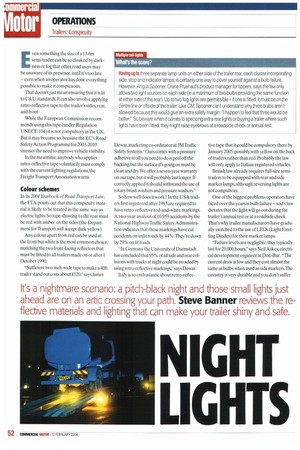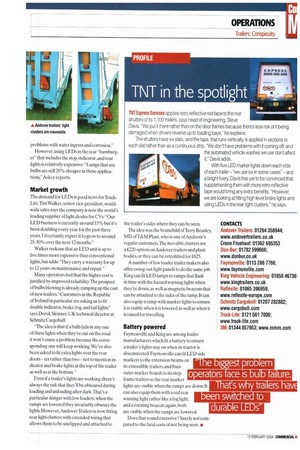NIGHT LIGHTS
Page 52

Page 53

If you've noticed an error in this article please click here to report it so we can fix it.
Ws a nightmare scenario: a pitch-black night and those small lights just ahead are on an artic crossing your path. Steve Banner reviews the re flective materials and lighting that can make your trailer shiny and safe.
Even something the size of a 13.6m semi-trailer can be so cloaked by darkness or fog that other road users may be unaware of its presence. until it's too late — even when an operator has done everything possible to make it conspicuous.
That doesn't just mean ensuringthat it is lit to C& U standards. It can also involve applying retro-reflective tape to the trailer's sides, rear, and front.
While the European Commission recommends using this tape (under Regulation UNECE 104) it is not compulsory in the UK. But it may become so, because the EC's Road Safety Action Programme for 2003-2010 stresses the need to improve vehicle visibility.
In the meantime, anybody who applies retro-reflective tape voluntarily must comply with the current lighting regulations, the Freight Transport Association warns.
Colour schemes
In its 2004 Yearbook of Road Transport Law, the FTA points out that this conspicuity material is likely to be treated in the same way as electric lights. So tape showing to the rear must be red with amber on the sides (the Department for Transport will accept dark yellow).
Any colour apart from red can be used at the front but white is the most common choice, matching the two front-facing reflectors that must be fitted to all trailers made on or after 1 October 1990.
"Sufficient two-inch-wide tape to make a 40ft trailer stand out costs about £120," says James Dewar, marketing co-ordinator at 3M Traffic Safety Systems." Ours comes with a pressure adhesive so all you need to do is peel off the hacking, but the surface it's going on must be clean and dryWe offer a seven-year warranty on our tape, but it will probably last longer. If correctly applied it should withstand the use of rotary brush washers and pressure washers."
So how well does it work? In the USA trailers first registered after 1993 are required to have retro-reflective red-and-white markings A two-year analysis of 10,959 accidents by the National Highway Traffic Safety Administration indicates that these markings have cut accidents on unlit roads by 44%.They're down by 29% on lit roads.
"In Germany the University of Darmstadt has concluded that 95% of all side and rear collisions with trucks at night could be avoided by using retro-reflective markings," says Dewar.
Italy is so enthusiastic about retro-reflec tive tape that it could be compulsory there by January 2005, possibly with yellow on the back of trailers rather than red. Probably the law will only apply to Italian-registered vehicles.
British law already requires full-size semitrailers to be equipped with rear and side marker lamps, although reversing lights are not compulsory.
One of the biggest problems operators have faced over the years is bulb failure — sod's law dictates that the light will go out during the trailer's annual test or at a roadside check. That's why trailer manufacturers have gradually switched to the use of LEDs (Light Emitting Diodes) for their marker lamps.
"Failure levels are negligible; they typically last for 20,000 hours," says Neil Askey, electrical development engineer at Don-Bur. "The current draw is low and they cost almost the same as bulbs when used as side markers:The circuitry is very durable and you don't suffer problems with water ingress and corrosion."
However, using LEDs in the rear-hamburger" that includes the stop, indicator, and rear lights is relatively expensive: "Lamps that use bulbs are still 20% cheaper in these applications,"Askey reports.
Market growth
The demand for LEDs is good news for TruckLite.Tim Walker, senior vice-president, worldwide sales, says the company is now the world's leading supplier of light diodes for CVs: "Our LED business is currently around 15% but it's been doubling every year for the past three years. I'd certainly expect it to grow to around 25-30% over the next 12 months."
Walker reckons that an LED unit is up to five times more expensive than conventional lights, but adds: "They carry a warranty for up to 12 years on maintenance and repair."
Many operators feel that the higher cost is justified by improved reliability:The prospect of bulbs blowing is already ramping up the cost of new trailers."Customers in the Republic of Ireland in particular are asking us to fit double indicator, brake, fog, and tail lights," says Derek Skinner, UK technical director at Schmitz Cargobull.
-The idea is that if a bulb fails in any one of these lights when they're out on the road it won't cause a problem because the corresponding one will keep working. We've also been asked to fit extra lights over the rear doorssix rather than two not to mention indicator and brake lights at the top of the trailer as well as at the bottom."
Even if a trailer's lights are working, there's always the risk that they'll be obscured during loading and unloading after dark.That's a particular danger with low loaders; when the ramps are lowered they invariably obscure the lights. However,Andoveraailers is now fitting rear light clusters with extended wiring that allows them to be unclipped and attached to the trailer's sides where they can be seen.
The idea was the brainchild of Terry Beasley, MD of UN Plant, who is one of Andover's regular customers.The movable clusters are a £220 option on Andover trailers and plant bodies, or they can be retrofitted for £625.
A number of low loader trailer makers also offer swing-out light panels to do the same job. King can fit LED lamps to ramps that flash in time with the hazard warning lights when they're down, as well as magnetic beacons that can be attached to the sides of the ramp. It can also equip a ramp with marker lights to ensure it is visible when it is lowered as well as when it is raised for travelling.
Battery powered
Faymonville and King are among trailer manufacturers which fit a battery to ensure a trailer's lights stay on when its tractor is disconnected. Faymonville can fit LED side markers to the extension beams on its extendible trailers, and fixes outer marker boards to its stepframe trailers so the rear marker lights are visible when the ramps are down. It can also equip them with a red rear warning light rather like a fog light, and a rotating beacon; again. both are visible when the ramps are lowered.






























































































































































































